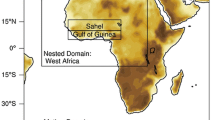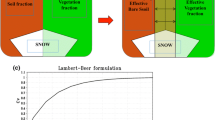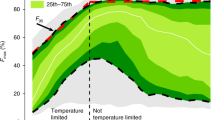Abstract
This paper analyzes the soil–atmosphere feedbacks and uncertainties under current (1960–1990) and plausible future climate conditions (2070–2100, using the A2 greenhouse gases emission scenario). For this purpose, two vegetation descriptions differing only in the grassland and grass-with-trees proportion in some parts of the domain have been created. The combination of these two different climate scenarios and two vegetation descriptions defines four different 30-year experiments, which have been completed using a regional climate model. The domain is centered around the Mediterranean basin and covers most of Europe. The study focuses on the summer season when there are major differences between the two vegetation descriptions and when the impact of land–surface processes on precipitation is largest. Present climate experiments show large evapotranspiration differences over areas where vegetation changes have taken place. Precipitation increases (up to 3 mm day−1 in some regions) follow evapotranspiration increases, although with a more complex spatial structure. These results indicate a high sensitivity at regional scales of summer precipitation processes to vegetation changes. Future climate simulations show very similar changes to those observed in the current climate experiments. This indicates that the impacts of climate change are relatively independent to the land-cover descriptions used in this study.







Similar content being viewed by others
References
Anthes RA, Hsie E-Y, Kuo Y-H (1987) Description of the Penn State/NCAR mesoscale model version 4 (MM4). Technical report NCAR technical note—282, NCAR, Boulder, CO 80307
Arribas A, Gallardo C, Gaertner MA, Castro M (2003) Sensitivity of the Iberian Peninsula climate to a land degradation. Clim Dyn 20:477–489
Baidya Roy S, Hurtt G, Weaver C, Pacala S (2003) Impact of historical land cover change on the July climate of the United States. J Geophys Res 108. doi:10.1029/2003JD003565
Blackadar A (1976) Modeling the nocturnal boundary layer. In: Amer B. Meteor Soc (eds) In: Proceedings of the third symposium on atmospheric turbulence. Diffusion Air Qual, pp 46–49
Castro M, Fernandez C, Gaertner MA (1993) Description of a mesoscale atmospheric numerical model. In: Diaz JI, Lions JL (eds) Mathematics, climate and environment. Rech Math Appl Ser Mason, pp 230–253
Chahine MT (1992) The hydrological cycle and its influence on climate. Nature 359:373–380
Chase T, Pielke R, Kittel T, Zhao M, Pitman A, Running S, Nemani R (2001) Relative climatic effects of landcover change and elevated carbon dioxide combined with aerosols: a comparison of model results and observations. J Geophys Res 106:31685–31691
Christensen JH, Christensen OB (2003) Severe summertime flooding in Europe. Nature 421:805–806
Copeland J, Pielke R, Kittel T (1996) Potential climatic impacts of vegetation change: a regional modeling study. J Geophys Res 101:7409–7418
Davies H (1976) A lateral boundary layer formulation for multilevel prediction models. Q J R Meteorol Soc 102:405–418
Diffenbaugh N (2005) Atmosphere–land cover feedbacks alter the response of surface temperature to CO2 forcing in the Western United States. Clim Dyn 24:237–251
Ducoudre N, Laval K, Perrier A (1993) SECHIBA, a new set of parameterizations of the hydrologic exchanges at the land–atmosphere interface within the LMD atmospheric general circulation model. J Clim 6:248–273
Gadd A (1978) A split explicit integration scheme for numerical weather prediction. Q J R Meteorol Soc 104:569–582
Gaertner M, Castro M (1996) A new method for vertical interpolation of the mass field. Mon Wea Rev 124:1596–1603
Gaertner M, Christensen O, Prego J, Polcher J, Gallardo C, Castro M (2001) The impact of deforestation on the hydrological cycle in the western Mediterranean: an ensemble study with two regional climate models. Clim Dyn 17:857–873
Gao X, Luo Y, Lin W, Zhao Z, Giorgi F (2003) Simulation of effects of land use change on climate in China by a regional climate model. Adv Atmos Sci 20:583–592
Garand L (1983) Some improvements and complements to the infrared emissivity algorithm including a parameterization of the absorption in the continuum region. J Atmos Sci 40:230–244
Garratt JR (1993) Sensitivity of climate simulations to land–surface and atmospheric boundary-layer treatments—a review. J Clim 6:419–448
Gedney N, Cox P, Duoville H, Polcher J, Valdes P (2000) Characterizing GCM land surface schemes to understand their responses to climate change. J Clim 13:3066–3079
Georgescu M, Weaver C, Avissar R, Walko R, Miguez-Macho G (2003) Sensitivity of model-simulated summertime precipitation over the Mississipi river basin to the spatial distribution of initial soil moisture. J Geophys Res 108. doi:10.1029/2002JD003107
Giorgi F, Bi X, Pal J (2004a) Mean, interannual variability and trends in a regional climate change experiment over Europe: I. present-day climate (1960–1990). Clim Dyn 22:733–756
Giorgi F, Bi X, Pal J (2004b) Mean, interannual variability and trends in a regional climate change experiment over Europe: II. climate change scenario (2071–2100). Clim Dyn 23:839–858
Giorgi F, Mearns L, Shields C, Mayer L (1996) A regional model study of the importance of local versus remote controls of the 1988 drought and the 1993 flood over the central United States. J Clim 9:1150–1168
Heck P, Luthi D, Wernli H, Schar C (2001) Climate impacts of European-scale anthropogenic vegetation changes: a sensitivity study using a regional climate model. J Geophys Res 106:7817–7835
Hsie E-Y, Anthes RA, Keyser D (1984) Numerical simulation of frontogenesis in a moist atmosphere. J Atmos Sci 41:2581–2594
Jacobsen I, Heise E (1982) A new economic method for the computation of the surface temperature in numerical models. Beitr Phys Atmos 55:128–141
Kain JS, Fritsch JM (1993) Convective parameterization for mesoscale models: the Kain-Fritsch scheme. the representation of cumulus convection in numerical models. Meteorol Monogr (Am Meteorol Soc) 46:165–170
Maynard K, Royer J-F (2004) Effects of “realistic” land-cover change on a greehouse-warmed African climate. Clim Dyn 22:343–358
Myneni RB, Hoffman S, Knyazikhin Y, Privette JL, Glassy J, Tian Y, Wang Y, Song X, Zhang Y, Smith GR, Lotsch A, Friedl M, Morisette J, Votava P, Nemani R, Running S (2002) Global products of vegetation leaf area and fraction absorbed PAR from year one of MODIS data. Remote Sens Environ 83:214–231
Nakicenovic N, Swart Re (eds) (2000) Emissions scenarios. A special report of working group III of the intergovernmental panel on climate change. Cambridge University Press, London, p 599
New M, Hulme M, Jones P (1999) Representing twentieth-century space-time climate variability. part I: Development of a 1961–90 mean monthly terrestrial climatology. J Clim 12:829–856
Olson JS (1994a) Global ecosystem framework-definitions. Technical report, USGS EROS Data Center internal report, Sioux Falls, pp 37
Olson JS (1994b) Global ecosystem framework-translation strategy. Technical report, USGS EROS Data Center internal report, Sioux Falls, pp 39
Pal J, Eltahir E (2001) Pathways relating soil moisture conditions to future summer rainfall within a model of the land–atmosphere system. J Clim 14:1227–1242
Pal J, Eltahir E (2003) A feedback mechanism between soil–moisture distribution and storm tracks. Q J R Meteorol Soc 129:2279–2297
Pal J, Giorgi F, Bi X (2004) Consistency of recent European summer climate trends and extremes with future regional projections. Geophys Res Lett 31:L13202
Pan Z, Arritt RW, Gutowski WJ, Takle ES (2001) Soil moisture in a regional climate model: simulation and projection. Geophys Res Lett 28:2947–2950
Pielke R, Walko RL, Steyaert L, Vidale P, Liston G, Lyons W, Chase T (1999) The influence of anthropogenic landscape changes on weather in South Florida. Mon Wea Rev 127:1663–1673
Pitman A, McAvaney B (2004) Impact of varying the complexity of the land surface energy balance on the sensitivity of the Australian climate to increasing carbon dioxide. Clim Res 25:191–203
Polcher J, Laval K (1994) A statistical study of the regional impact of deforestation on climate in the LMD-GCM. Clim Dyn 10:205–219
Pope V, Gallani M, Rowntree P, Statton R (2000) The impact of new physical parameterizations in the Hadley Centre climate model: HadAM3. Clim Dyn 16:123–146
Räisänen J (2002) CO2-induced changes in interannual temperature and precipitation variability in 19 CMIP2 experiments. J Clim 15:2395–2411
Räisänen J, Hansson U, Ullerstig A,Döscher R, Graham L, Jones C, Meier H, Samuelson P, Willen U (2004) European climate in the late twenty-first century: regional simulations with two driving global models and two forcing scenarios. Clim Dyn 22:13–31
Rayner NA, Parker DE, Horton EB, Folland CK, Alexander LV, Rowell DP, Kent EC, Kaplan A (2003) Global analyses of sea surface temperature, sea ice, and night marine air temperature since the late nineteenth century. J Geophys Res 108. doi:10.1029/2002JD002670
Rowell DP (2005) A scenario of European climate change for the late twenty-first century: seasonal means and interannual variability. Clim Dyn 25:837–849
Schär C, Luthi D, Beyerle U, Heise E (1999) The soil–precipitation feedback: a process study with a regional climate model. J Clim 12:722–741
Seneviratne S, Pal J, Eltahir E, Schar C (2002) Summer dryness in a warmer climate: a process study with a regional climate model. Clim Dyn 20:69–85
Stephens G (1978) Radiation profiles in extended water clouds. II: Parameterization schemes. J Atmos Sci 35:2123–2132
Suh M-S, Lee D-K (2004) Impacts of land use/cover changes on surface climate over east Asia for extreme climate cases using RegCM2. J Geophys Res 109. doi:10.1029/2002JD002670
Vidale P, Luthi D, Frei C, Seneviratne S, Schar C (2003) Predictability and uncertainty in a regional climate model. J Geophys Res 108. doi:10.1029/2002JD002810
Voldoire A, Royer J (2004) Tropical deforestation and climate variability. Clim Dyn 22:857–874
Von Storch H, Zwiers F (1999) Statistical analysis in climate research. Cambridge University Press, London, p 484
Zhang DL, Anthes RA (1982) A high resolution model of the planetary boundary layer-sensitivity test and comparisons with SESAME-79 data. J Appl Meteorol 21:1594–1629
Zhao M, Pitman A, Chase T (2001) The impact of land cover change in the atmospheric circulation. Clim Dyn 17:467–477
Zheng Y, Yu G, Qian Y, Miao M, Zeng X, Liu H (2002) Simulations of regional climatic effects of vegetation change in China. Q J R Meteorol Soc 128:2089–2114
Acknowledgments
E. Sánchez has been funded by PRUDENCE European project (Prediction of Regional scenarios and Uncertainties for Defining EuropeaN Climate change risks and effects, EVK2-CT-2001-00132). We thank the useful comments of the anonymous reviewers, which have substantially improved the quality of the paper.
Author information
Authors and Affiliations
Corresponding author
Rights and permissions
About this article
Cite this article
Sánchez, E., Gaertner, M.A., Gallardo, C. et al. Impacts of a change in vegetation description on simulated European summer present-day and future climates. Clim Dyn 29, 319–332 (2007). https://doi.org/10.1007/s00382-007-0240-2
Received:
Accepted:
Published:
Issue Date:
DOI: https://doi.org/10.1007/s00382-007-0240-2




